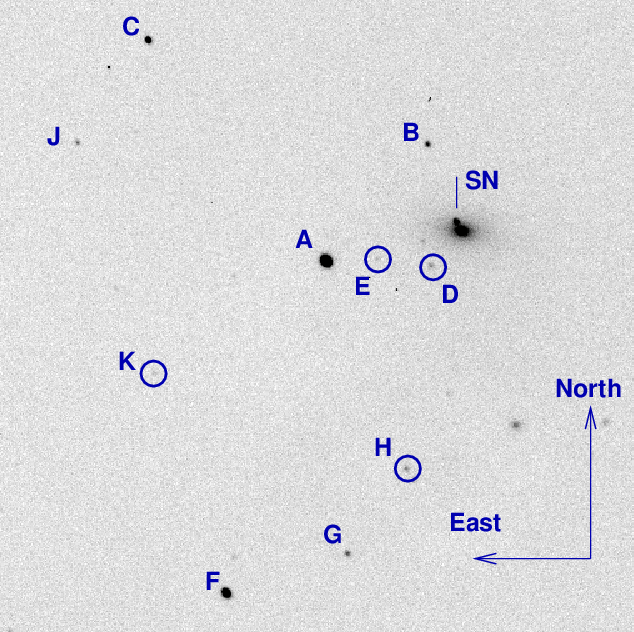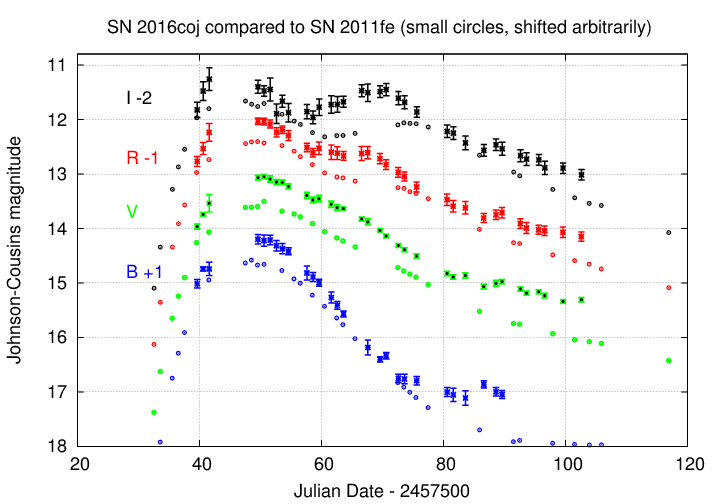
On the night of Aug 01/02, 2016, I observed SN 2016coj in NGC4125. I also observed the Landolt calibration fields PG1633, Mark A, and PG2213.
The main setup was:
Notes from the night
SN 2016coj is a Type Ia supernova in the relatively nearby galaxy NGC4125. It was discovered by the KAIT group some time before maximum light:
NGC 4125 RA = 12:08:05.7 Dec = +65:10:30 (J2000)

The AAVSO sequence team kindly provided photometry for stars near this object. You can see their full photometric sequence on their website. Below, I show only the members of that sequence which fall into my very small field of view -- taken from AAVSO sequence X16288FJI. Note that star "K" is so faint that I may not detect it clearly in B-band.
letter B sigB V sigV R sigR I sigI ------------------------------------------------------------------------ B 15.198 0.086 14.133 0.052 13.627 0.116 13.155 0.156 C 13.317 0.093 12.673 0.058 12.316 0.121 11.980 0.161 J 15.607 0.109 14.956 0.065 14.603 0.136 14.271 0.182 K 16.573 0.123 15.975 0.082 15.547 0.174 15.147 0.231 -------------------------------------------------------------------------
I created a master dark frame for the SN 2016coj images by combining sets of 10 dark frames taken before sunset and after the SN images.
I took sets of 10-13 images in each filter, guiding in all filters. The guiding worked fine with an exposure time of 5 seconds. I discarded any trailed images.
I used focus settings based on relative positions measured for a bright star earlier. At a temperature of T = 24 C, I determined
Normally, the telescope drifts slightly to the South during long exposures. To avoid backlash in the Dec gear, I move to the field from the South. But NGC 4125 is so far to the West that it starts to move "under the pole" during the latter half of my observing runs, and that seems to reverse the telescope's drift. Therefore, before starting the I-band images, I nudged the telescope North, to reset the gears and avoid backlash.
As explained in the notes to Jun 14, 2016, I used the "rotsub" technique to remove the galaxy's light at the position of the SN.
On this night, I used "method 2", which means performing "rotsub" on each individual image, then combining all the resulting images in a passband to make a "master rotsub" image.
Using aperture photometry with a radius of 4 pixels (radius of 5.5 arcsec) I measured the instrumental magnitudes of a number of reference stars and the target. Following the procedures outlined by Kent Honeycutt's article on inhomogeneous ensemble photometry, I used all stars available in each image to define a reference frame, and measured each star against this frame. I used the interim reference magnitudes above plus color terms which I am currently revising -- so please treat these results as preliminary to convert the ensemble instrumental magnitudes to the standard Johnson-Cousins BVRI scale.
Note that in the graph below, I combine data calibrated with UCAC4 photometry (first few weeks) with recent data calibrated with AAVSO photometry. That's inconsistent, and I'll re-compute all magnitudes later. Note further that I use only 2 AAVSO stars (B and C) for calibration, for consistency with earlier measurements; I'll use additional stars in my final calculations.
filter mag mag_uncert Julian Date
SN V = 15.308 +/- 0.041 (ens 0.035 zp 0.022) 2457602.60463
SN R = 15.149 +/- 0.085 (ens 0.028 zp 0.081) 2457602.58785
SN I = 15.016 +/- 0.097 (ens 0.044 zp 0.086) 2457602.62557
Below is a preliminary light curve, based on RIT Observatory measurements. I also show measurements of SN 2011fe in M101, an ordinary type Ia supernova, shifted arbitrarily.

Last modified 08/03/2016 by MWR.